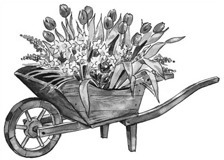by Debbie Ornquist
Leaves
The close of the gardening season is always bittersweet. Though there are few more beautiful places on earth than Minnesota in the autumn, I just hate saying goodbye to all my plants and trading this lush, green world for one that’s cold and white.
But there are also plenty of good things about fall. The weather is cool and the humidity is low. Once we’ve had our first killing frost, the frantic pace of the harvest season is over. It’s time for apples and potatoes, pumpkins and mums. And, it’s time to reap the season’s most abundant crop: leaves.
The longer I garden, the greater my appreciation for the value of organic matter. And one of the very best sources of organic matter is autumn leaves.
Leaves are packed with trace minerals that trees draw up from deep in the soil. When added to your garden, leaves feed earthworms and beneficial microbes. They lighten heavy soils and help sandy soils retain moisture. They make an attractive mulch in the flower garden. They’re a fabulous source of carbon to balance the nitrogen in your compost pile. And they insulate tender plants from cold.
Here are a few easy ways that I’ve found to put leaves to work in my garden.
First, shred up as many of them as you can. I don’t have a leaf shredder, I let the leaves pile up on the lawn and then drive over them a few times with the lawn mower. Shredding one leaf into five or ten smaller pieces does several good things. It increases the surface area, giving microbes many more places to work. It prevents the leaves from packing together into layers that won’t let water or air penetrate. And it reduces the volume dramatically. Once the leaves are shredded, I rake them up. Most of them go into plastic trash bags that get stashed in the barn for next spring when I’ll use them as mulch in my perennial gardens. In time, shredded leaves become something called leaf mold, which makes a fabulous mulch. What’s more, it does wonders for the soil, and I like the look of it.
As for the rest of the shredded leaves, some get put aside for a month or so to be used for mulching my garlic, tender perennials and roses. The rest get carted over to the vegetable and cutting gardens.
Not all the leaves in my yard get shredded, though if I had the time I’d probably do so. By November, I’ve usually run out of steam and simply pack the rest of the whole leaves into my compost bin. I add these leaves to the working compost pile throughout the year to balance the food scraps and other materials that are usually high nitrogen. The leaves also keep the pile from getting compacted and soggy.
For me, keeping busy is the best way to fend off the blues, which is how I sometimes feel as winter approaches. Raking and hauling and digging and spreading keep me moving and my gardens just get better and easier to care for every year.
If you have an abundant source of leaves in the fall, shred them. Your garden will benefit in a big way. Here’s how to use them: Insulate Tender Plants: A 6-inch blanket of leaves protects tender plants from winter wind and cold.
Boost Your Compost Pile: Carbon-rich leaves balance high-nitrogen compost ingredients such as fresh grass clippings.
Improve Your Soil: Mix shredded leaves right into your garden. Next spring, your soil will be teeming with earthworms and other beneficial organisms.
Make “Leaf Mold”: Simply rake the leaves into a big pile. If you shred them, they will decompose faster, but you can still make leaf mold without shredding. After one to three years, fungus will have broken the leaves down to a special compost that smells like a walk through the woods. Leaf mold is high in calcium and magnesium and retains three to five times its weight in water—rivaling peat moss.


